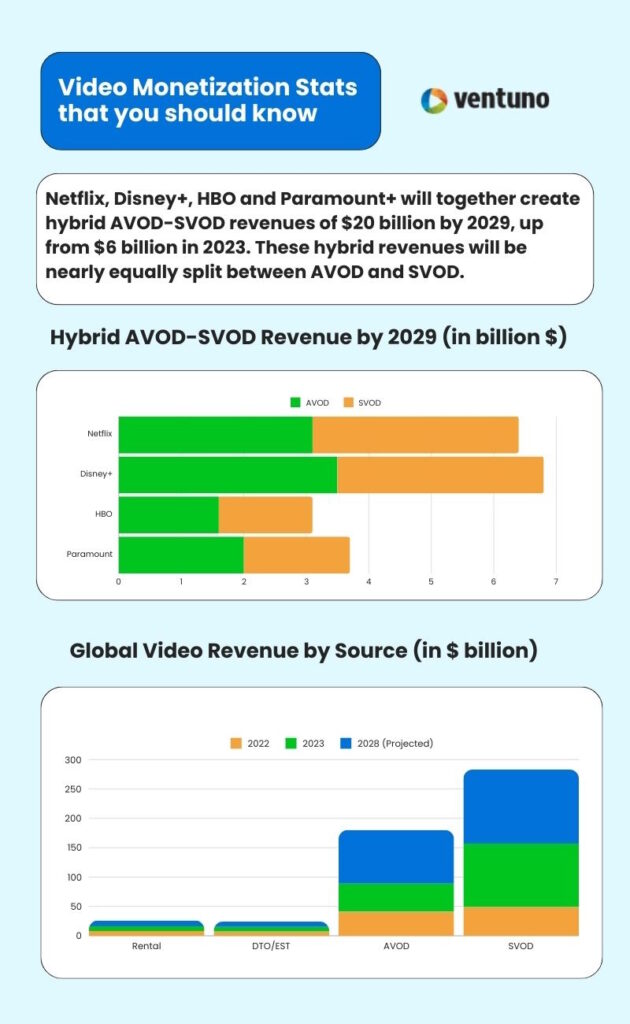SVOD, AVOD or TVOD: Choose the best for your video business
Last Updated on May 27, 2025 by Anjana Devi
When Netflix started in 1997, it disrupted the video rental industry by selling and renting DVDs through postal service. Now, not many people remember buying VHS tapes and DVDs from video renting stores.
In 2007, Netflix again disrupted the video industry by introducing Video on demand as one of their core services. As Internet speed increased coupled with people’s habit of binge-watching, Netflix’s VOD service grew exponentially while its DVD sales declined.
Today, launching a successful streaming service largely depends on choosing the right video on demand (VOD) model. Whether you’re a seasoned streaming service owner or just stepping into the market, understanding the various VOD models is crucial to your business strategy. The three primary models—Subscription Video On Demand (SVOD), Advertising Video On Demand (AVOD), and Transactional Video On Demand (TVOD)—each offer distinct advantages and challenges.
As we go through each of these VOD models in this guide, we will explore how they work, platforms and services that use these models, and the pros and cons of each model.
By the end, you’ll have a clear understanding of which model aligns best with your content, audience, and revenue goals, setting you on the path to making an informed decision for your streaming business.
With a market size of USD 375.1 billion in 2021, the global video streaming market is expected to reach USD 1,721.4 billion by 2030, representing an 18.45% CAGR. from 2022 to 2030.
Most of the content creators have already launched or are planning to launch their video streaming service to join the bandwagon.
As a content creator, what are your options to monetize your video streaming service? Let’s take a look.

Subscription-based Video on Demand aka SVOD
SVOD is a business and revenue model where users pay a recurring fee to access a library of video content. In this model, consumers typically pay monthly or annually through subscriptions.
This model is popular due to its ability to generate steady revenue, foster customer loyalty, and offer a diverse range of content that caters to various tastes and preferences.
The viewer agrees to pay a recurring fee to gain access to your video service. It’s generally a monthly, quarterly or annual fee. This means viewers can watch all that they want, any time they want with no restrictions. Netflix, Amazon Prime, and Hulu follow this model.
SVOD model offers plenty of flexibility to the viewers. They can choose subscription of any duration and opt-out anytime. Viewers don’t need to pay different price for viewing different content as everything is covered under the same recurring fee.
SVOD is a great model for content creators to monetize their service. As an SVOD service provider, you get consistent revenue from your subscribers which is fairly predictable. For example, if you have 100 paying subscribers and charge them $5/ month, you generate a revenue of $500/ month. Predicting your future revenue is easy once you know your Net MRR Growth Rate i.e. the month-over-month percentage increase in your monthly revenue.
To be successful in the SVOD model, your focus should be both to retain subscribers and add new ones. If you produce premium content frequently and in longer formats i.e. greater than 30 minutes, like online courses, training material or originals, this model suits you.
How Does SVOD Work?
Let’s break down how it works for you and your subscribers
1. Subscription Payment: Users subscribe to your service by paying a recurring fee, which can be monthly, quarterly, or annually. This fee allows them to access you entire content library without additional charges for individual titles.
2. Content Access: Once subscribed, users can watch as much content as they desire within the subscription period.
3. Device Compatibility: Now your subscribers want to access your SVOD service on various devices, including smartphones, tablets, smart TVs, and computers, allowing them to watch content from anywhere.
4. Content Updates: To keep them subscribed you will have to frequently update your content libraries with new releases, exclusive content, and seasonal additions to keep your service appealing and engaging for your subscribers.
SVOD Platforms & Services
We all know Netflix offers a diverse range of films, TV series, documentaries, and original productions.
There are a number of reasons why it is so popular, including personalized recommendations, multiple user profiles, and a large library of content from around the world.
There are also niche SVOD services like kweliTV – a streaming service dedicated to celebrating global black culture through curated films, documentaries, web series, and children’s programming.
This streaming service is known for its focus on underrepresented voices and stories from the African diaspora, offering content in multiple languages and subtitles for accessibility.
Pros of SVOD
1. Steady and Predictable Revenue Stream:
The subscription model ensures a consistent revenue flow as long as subscribers remain active.
2. High Customer Retention:
Recurring subscriptions encourage long-term engagement, with users continuously accessing and consuming content.
3. Deeper Customer Engagement:
Subscribers often develop loyalty to the service, especially when exclusive content is offered.
Cons of SVOD
1. High Content Acquisition Costs:
To attract and retain subscribers, you will have to first invest heavily in acquiring and producing high-quality content.
2. Intense Competition:
The market is crowded with numerous SVOD services, making it challenging to stand out and attract subscribers.
3. Subscriber Fatigue and Churn Risks:
With many subscription services available, users may experience subscription fatigue, leading to cancellations and the need for continuous marketing and content updates to retain subscribers.
Transaction-based Video on Demand aka TVOD
While SVOD is like an all-you-can-eat-buffet, TVOD is like ordering à la carte. Viewers get to pick and choose what they want to watch and only pay for that particular content.
Movies, series and sporting events choose this model to get higher revenue per view. TVOD model does not have the same retention as the SVOD service as, unlike SVOD model, viewers pay only when they want to watch a particular content. Examples of TVOD services are YouTube Movies and Google Play.
As a content creator, if you want to venture into TVOD, you need to have a marketing effort to go along with production. You also need to have a huge dedicated audience to make this profitable. Keep in mind that your growth depends directly on the number of new customers.
How Does TVOD Work?
1. Content Selection: Users browse their content library and select the specific movie, episode, or event they want to watch.
2. Payment: Users pay a one-time fee for the selected content. This fee can vary depending on the content’s release date, popularity, and quality (e.g., HD or 4K). You can price it in a way that best suits each piece of your content
3. Access Period: After payment, users can watch the content. While some platforms offer permanent access, others offer rentals with a limited viewing period (e. g., 24-48 hours).How you can offer your content depends on the nature of your content.
TVOD Platforms and Services
Movies and TV shows can be purchased or rented from iTunes shortly after they are released in theaters.
iTunes gained popularity for its high-quality video and audio options, seamless integration with Apple devices, and frequent promotions.
Vudu is another TVOD streaming service that specializes in offering high-definition movies and TV shows for rental or purchase, often with early access to new releases.
Pros of TVOD
1. High Revenue Per Transaction:
Each purchase or rental can generate significant revenue, especially for popular or newly released content.
2. Consumer Flexibility:
Users can choose to pay only for the content they want to watch, without a long-term commitment.
3. Appeal for Niche Content:
TVOD is well-suited for niche markets and special events, offering content that may not be available on subscription services.
Cons of TVOD
1. Less Predictable Revenue Stream:
Revenue depends on individual transactions, which can fluctuate based on demand and market trends.
2. High Competition for Individual Titles:
Content must stand out to attract viewers, often requiring significant marketing efforts.
3. Lower Engagement Levels:
Without a subscription, users may not return to the platform regularly, leading to lower overall engagement.
Advertising-based Video on Demand aka AVOD
AVOD is a model where users can access video content for free, but with advertisements integrated into the viewing experience.
This model allows content providers to monetize their offerings through ad revenue instead of charging viewers a subscription or transaction fee. AVOD is popular among consumers who are willing to watch ads in exchange for free access to content.
Think of YouTube. Users watch content for free and creators earn revenue from advertisements. It is a powerful model and works well for creators who generate a lot of views.
As a content creator, AVOD is a great model if your videos generate a lot of views and if people are not ready to pay for viewing them. In general, the AVOD model suits News, Lifestyle and Entertainment categories.
With AVOD, you need to have direct relationships with advertisers who are willing to run ads on your content. You also need to have a constant tab on CPM rates and fill rates to ensure that you generate a significant revenue from ads.
How does AVOD Work?
AVOD works by integrating advertisements into the video content users watch. Let’s break it down
1. Content Availability: Users can access your content, like movies, TV shows, and web series, without any upfront cost.
2. Ad Integration: You have to strategically place advertisements before, during, or after the video content. These are called pre-roll, mid-roll, and post-roll ads.
3. Revenue Generation: Advertisers pay you based on various metrics, such as impressions, clicks, and conversions. The platform earns revenue from these ad placements.
AVOD Platforms and Services
Pluto provides a variety of live TV channels and on-demand content, all supported by advertisements.
People are opting more often for these free services to save some money.
Pros of AVOD
1. Free Access Attracts a Large Audience:
The no-cost nature of AVOD makes it accessible to a broad audience, increasing viewership.
2. Monetization Through Ads:
AVOD platforms can generate substantial revenue from advertisers, especially with high viewership numbers.
3. Lower Barrier to Entry & Retention of Viewers:
Users do not need to commit to subscriptions or payments, making it easier to attract and retain viewers.
Disadvantages of AVOD
1. Unpredictable Ad Revenue:
Revenue can fluctuate based on ad market conditions, viewer engagement, and ad performance.
2. User Experience Can Be Disrupted by Ads:
Frequent or poorly placed advertisements can lead to a negative viewing experience and potentially drive viewers away.
3. Need for High Viewer Numbers:
To generate significant revenue, AVOD platforms need to maintain a large and active user base, which can be challenging.
Comparing SVOD, AVOD, and TVOD: Key Difference
Hybrid model that combines SVOD, TVOD and AVOD
If you have the bandwidth, you can combine two or three models to maximize your returns. Consider Hotstar, India’s largest OTT service. Viewers watch non-premium content for free (AVOD) and pay a subscription fee for watching premium content (SVOD). Viewers also have the option to watch live sports by paying a one-time fee (TVOD).
How to Make the Most of Hybrid Models
Hybrid models combine elements of SVOD, AVOD, and TVOD to create a more flexible and comprehensive streaming service. This approach can help maximize revenue, reach a broader audience, and provide users with more viewing options. Here’s how to leverage hybrid models
1. Offer Tiered Subscription Plans
Tier your plans like basic, standard and Premium. For example
- Basic (AVOD): Free access with ads. This attracts a large audience and generates ad revenue.
- Standard (SVOD): Paid subscription with ad-free access to a wide range of content.
- Premium (SVOD + TVOD): Higher subscription fee that includes additional benefits such as early access to new releases or exclusive content, along with options for pay-per-view events.
2. Content Segmentation
Segment your content based on its populatity, freshness, shelf life, demand or whatever you see fit based on your niche. For example
- Free Content: Offer a selection of popular content for free with ads to draw in viewers.
- Exclusive Content: Keep premium and exclusive content behind a paywall to incentivize subscriptions.
- Pay-Per-View Events: Offer new releases, special events, or niche content on a transactional basis to cater to specific audience interests.
3. Flexible Payment Options
Allow users to choose between monthly and annual subscriptions, with discounts for long-term commitments.
Offer bundle deals combining SVOD, AVOD, and TVOD options at a reduced rate.
4. Personalized Experience
Use data analytics to understand viewer preferences and suggest relevant content.
Customize ad experiences to make them more relevant and less intrusive.
5. Marketing and Promotions
Promote free AVOD content to attract new users and upsell them to SVOD or TVOD options.
Use limited-time offers and discounts to convert AVOD users to paying subscribers.
FAQ
FAQ
When deciding between SVOD and TVOD, consider your content and audience. SVOD is ideal if you have a large, diverse library that can keep viewers engaged over time, attracting those who prefer binge-watching and continuous access for a recurring fee. On the other hand, TVOD suits platforms with high-demand, exclusive, or new content, appealing to viewers willing to pay per title, and providing high revenue per transaction but with less predictability.
Choosing between AVOD and ad-free SVOD depends on your target audience and revenue goals. AVOD is perfect for reaching a broad audience with free access supported by ads, attracting viewers who don’t mind advertisements. In contrast, ad-free SVOD caters to those willing to pay for an uninterrupted viewing experience, offering steady subscription revenue and higher retention, ideal for premium content libraries.
Yes, combining SVOD, AVOD, and TVOD can maximize revenue and audience reach. For example, offer a free ad-supported tier, a premium ad-free subscription, and pay-per-view options for new releases or exclusive content.
Subscriptions: Pricing should be competitive yet reflective of the content value and exclusivity. Typical monthly fees range from $5 to $15.
Rentals: Prices for renting individual titles can vary from $1.99 to $5.99, depending on the content’s popularity and release date.
Advertising revenue is generated based on metrics such as ad impressions, clicks, and viewer demographics. The more viewers and engagement your platform has, the higher the potential ad revenue.
Yes, tiered subscriptions can cater to different audience segments. For example, a free ad-supported tier, a standard ad-free tier, and a premium tier with additional perks like exclusive content or early access.
Popular content types include current TV shows, blockbuster movies, exclusive original series, niche content like documentaries or anime, and special events or live streams.
Regular content updates keep viewers engaged. Weekly releases for new episodes, monthly additions of new titles, and seasonal specials are effective strategies.
Build relationships with content creators and distributors. Consider revenue-sharing deals, licensing agreements, or producing original content to control costs.
Research your audience’s willingness to pay and preferences. Offer a variety of plans to cater to different budgets and viewing habits. Use promotions and discounts to attract new subscribers.
Offer exclusive content, and regular content updates to keep the platform fresh. Implement loyalty programs, bundle deals, and special offers to retain subscribers and reduce churn.
Summary
Which model is best for your video business? There are no hard and fast rules and it all depends on the video type, quality, frequency of uploads and user’s willingness to pay for it.
If you are a Yoga or fitness instructor, SVOD works best for you. You can create high-quality training videos for which users are ready to pay.
If you are a News or Entertainment content creator and if your users are not willing to pay to watch your videos, then probably AVOD works best for you.
If you are a Sports content creator and regularly broadcast live events, you can go ahead with the TVOD model and charge your users a one-time fee to watch the event. TVOD also works well for creators who have a huge library of premium content like movies and TV series.
If you produce both medium and high-quality videos and want to attract users to your service before asking them to pay, then a combination of AVOD and SVOD would work best for you. You can attract users by giving your non-premium content for free and charging your users for premium content.
All these models work well if chosen and utilized correctly. Each model has its own parameters for effortless percolation into revenue and growth. You have to take a hard look at what works best for you and start using technology to your favor to not just grow but retain eyeballs.
We at Ventuno are keen to help you maximize your revenue from OTT. With Ventuno’s OTT SaaS platform for content creators, you can launch your branded video streaming service for web, mobile and connected TV within 24 hours. You have full control over how you want to monetize (AVOD, SVOD, TVOD) and keep 100% of the revenue. Once your service is launched, you use a single platform to manage, monetize and grow your video business.
Looking to launch your streaming app?




